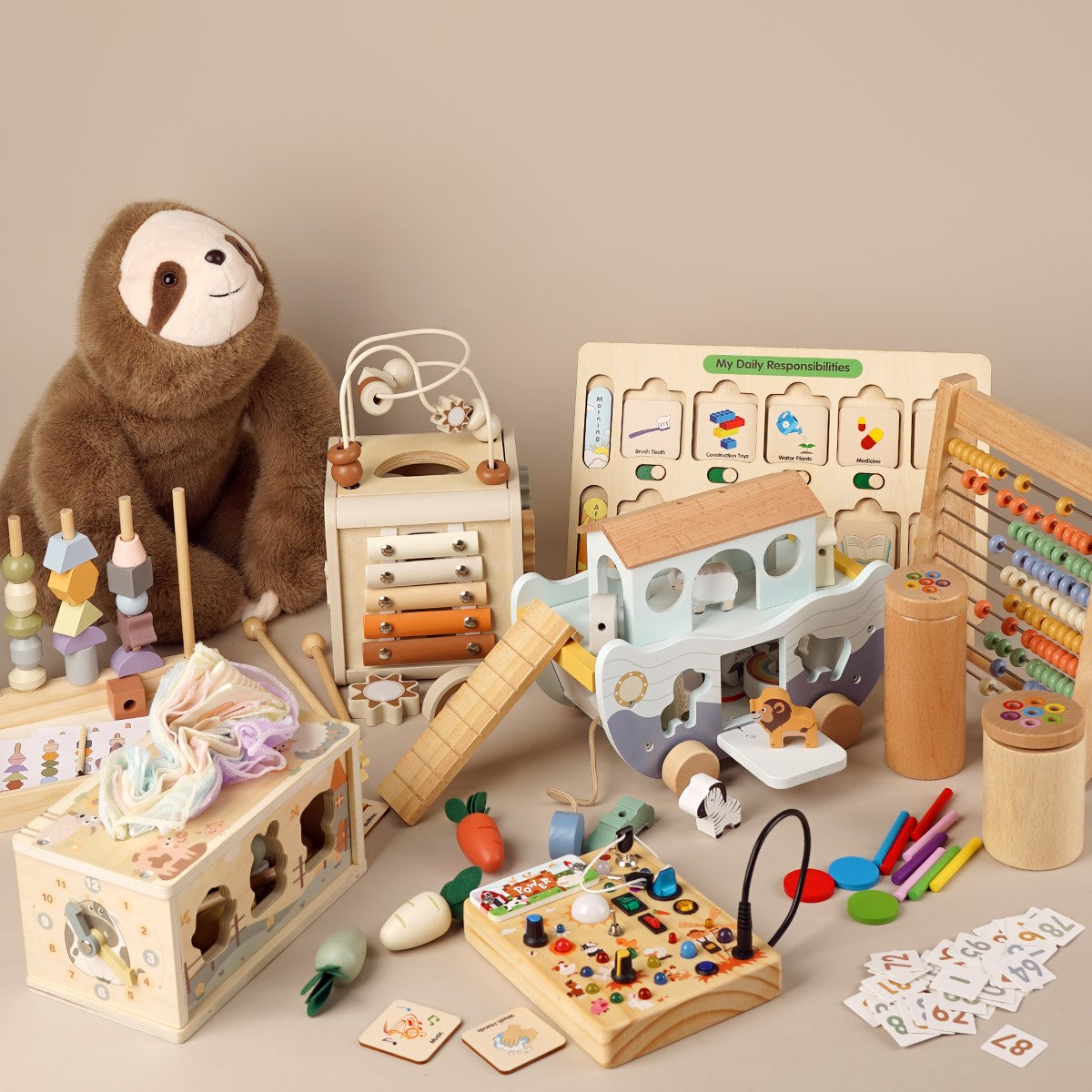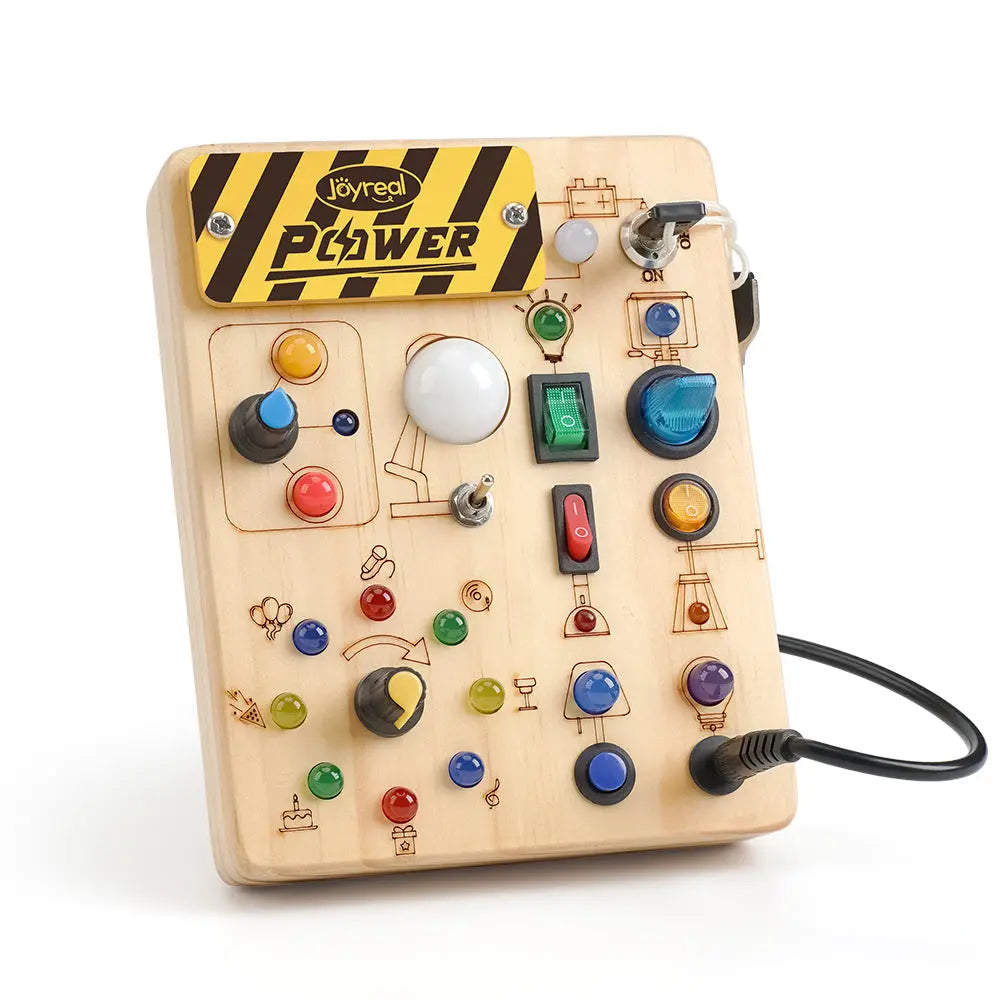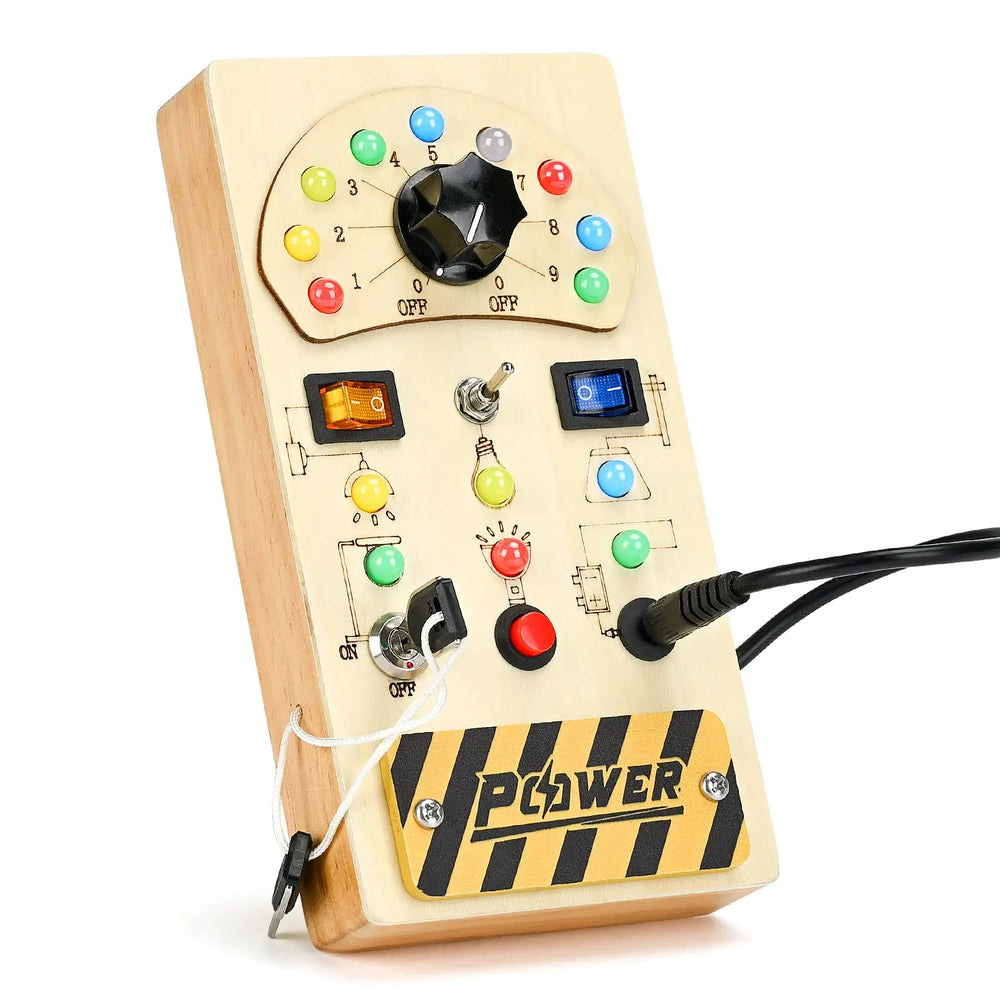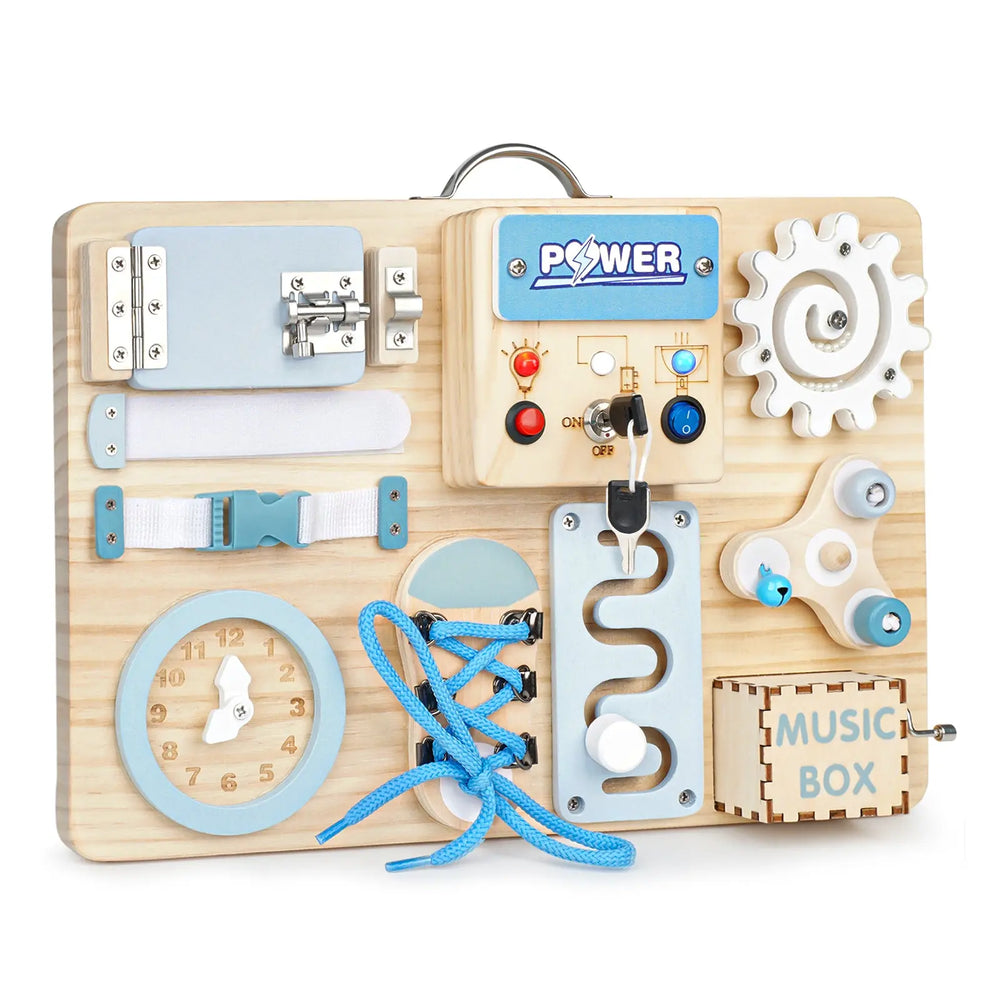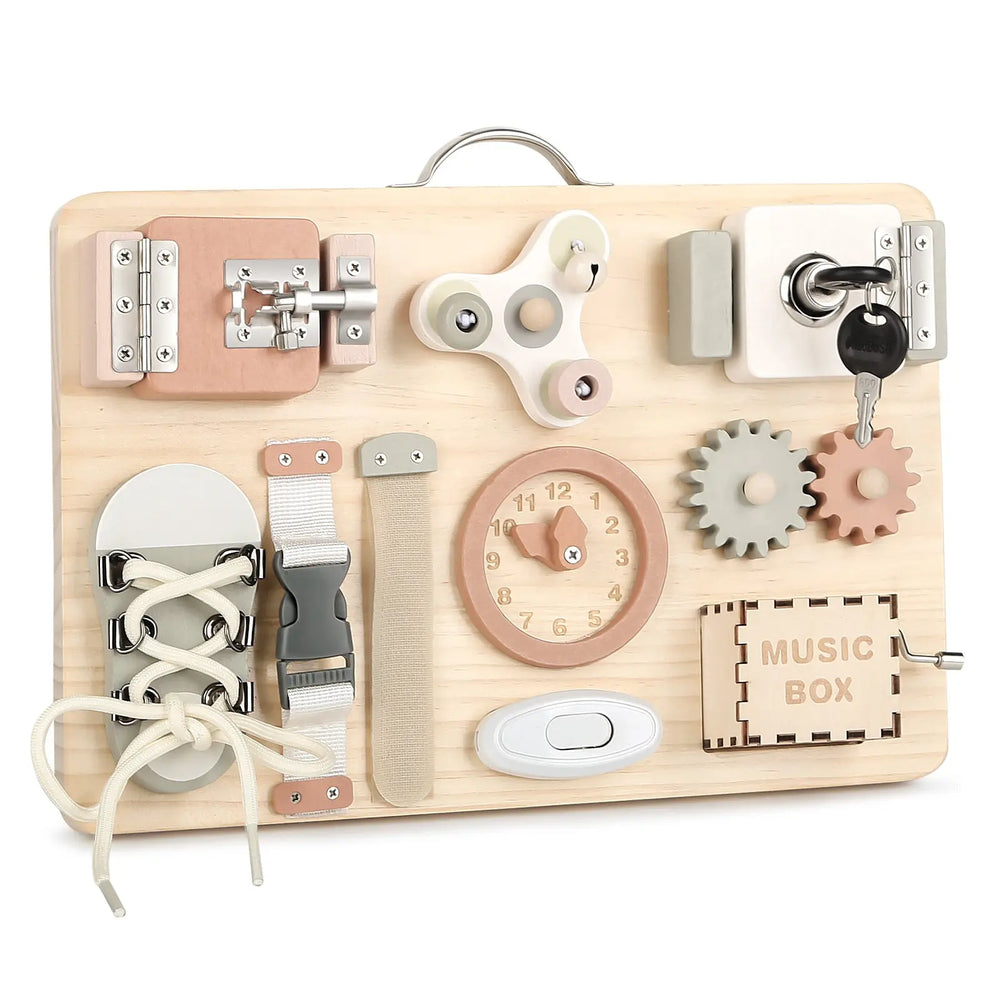Montessori Busy Boards by Age: Safe, Skill-Building Toys for 10 Months to 4 Years

Montessori education is centered on fostering independence, curiosity, and skill development through hands-on learning. A key aspect of this method is using age-appropriate materials that align with a child’s developmental stage, helping them build confidence and mastery.
Why Age-Appropriate Montessori Materials Matter
Montessori materials are carefully designed to meet children’s physical, cognitive, and emotional needs at different stages:
- Encourage independence – Materials should be easy for the child to use with minimal adult help.
- Match motor skills – A toddler’s materials should suit their developing grip, while older children handle more complex tools.
- Support cognitive development – Each material introduces challenges that align with the child’s problem-solving abilities.
- Foster intrinsic motivation – Children naturally engage when the material is neither too easy nor too frustrating.
The montessori busy board is a timeless toy that adapts to your child’s evolving abilities. While it’s ideal for toddlers aged 10 months to 4 years, its simplicity and depth ensure even older preschoolers enjoy revisiting it.
Ideal Age Range for Busy Boards
While every child develops uniquely, busy boards are typically suited for toddlers aged 10 months to 4 years. Here’s a breakdown of how they support different stages:
1. 10–18 Months: Early Explorers
At this age, babies are curious about cause-and-effect relationships. Simple activities like flipping switches, spinning gears, or patting textured fabrics on a busy board captivate their interest. These tasks enhance sensory awareness and basic motor skills.
Key features: Soft fabrics, large knobs, and easy-to-grasp elements.
2. 18 Months–3 Years: Skill Builders
Toddlers in this phase thrive on mastering practical life skills. Busy boards with zippers, buckles, door latches, or shoelaces help them refine fine motor control and build confidence. The repetitive practice aligns with Montessori’s focus on independence (e.g., “I can dress myself!”).
Key features: Challenges that mimic real-world tasks, like buttoning or using a lock.
3. 3–4 Years: Advanced Problem-Solvers
Older toddlers enjoy more complex activities, such as puzzles, counting beads, or matching shapes. Busy boards for this age group may incorporate basic math or literacy elements, fostering cognitive development alongside motor skills.
Key features: Multi-step tasks, numbers, or alphabets.
Safety Considerations
- For younger babies (under 12 months): Ensure all parts are securely fastened and too large to choke on. Avoid small detachable pieces.
-
For older toddlers: Supervise sharp or intricate components (e.g., metal hooks) to prevent frustration or accidents.
Why Choose a Montessori Busy Board?
A busy board is essentially a training ground for life skills," explains child development specialist Dr. Emma Peterson. "The repetitive practice of opening, closing, and manipulating objects builds both physical coordination and cognitive understanding.
1. Motor Skills Mastery
The varied components (locks, latches, zippers) provide graduated challenges that:
- Improve hand-eye coordination
- Develop bilateral coordination (using both hands together)
- Prepare hands for pencil grip and scissor use
2. Cognitive Skill Builder
Each element serves as a mini puzzle that:
- Teaches cause-and-effect relationships
- Develops logical sequencing skills
- Enhances spatial reasoning abilities
3. Emotional Growth Accelerator
Through self-directed play, children gain:
- Increased confidence as they master challenges
- Improved frustration tolerance
- Longer attention spans (typically 15-30 minutes of focused play)
Choosing the Right Board
For optimal development, look for boards that:
- Use natural materials (wood, metal, fabric)
- Include 8-12 varied activities
- Grow with your child (removable/reconfigurable parts)
- Feature real-life components (not plastic imitations)
"Quality matters," emphasizes Montessori educator Lisa Chen. "A well-made busy board becomes a trusted companion through multiple developmental stages."
The Lasting Impact
Children who regularly engage with busy boards typically show:
- Earlier self-dressing capability (by 12-18 months earlier than peers)
- Smoother transitions to preschool routines
- Increased problem-solving confidence
- Better preparedness for academic tasks
Investing in a Montessori busy board isn't just about keeping little hands busy - it's about setting the foundation for lifelong learning success. As parents report, the benefits continue revealing themselves long after the toddler years, with many school-aged children demonstrating advanced fine motor control and creative problem-solving abilities.
For a learning tool that truly grows with your child while making skill development enjoyable, the Montessori busy board remains unparalleled. It's not just a toy - it's an investment in your child's future capabilities.
Why Joyreal Toys Stand Out
- Age-Specific Designs: From soft-textured boards for curious 10-month-olds to advanced puzzle panels for preschoolers, our toys grow with your child’s developmental needs.
- Natural Materials: We use sustainably sourced wood, organic fabrics, and non-toxic finishes to ensure safe, eco-friendly play.
- Real-Life Skill Building: Our busy boards feature functional elements like zippers, latches, and counting beads, empowering kids to master practical tasks joyfully.
-
Parent-Trusted Quality: Every product is rigorously tested for safety and durability, so it withstands years of exploration.
Whether you’re starting your Montessori journey or deepening your child’s learning, Joyreal toys offers tools that spark curiosity, focus, and confidence.
What Age Does Montessori Stop?
The Montessori philosophy doesn't conclude—it evolves. While its early childhood programs are most visible, Montessori's core principles of independence, curiosity, and developmental respect transcend age boundaries. As Dr. Maria Montessori profoundly observed, "Education is a natural process carried out by the child, and is acquired not by listening to words, but by experiences in the environment."
From Classroom to Life
Formal Montessori education typically spans infancy through adolescence (0-18 years), with each stage—Nido, Toddler, Primary, Elementary, and Adolescent—uniquely tailored to developmental needs. Yet the approach's true power lies in its timeless applicability:
- For Children: Hands-on materials cultivate concrete skills and abstract thinking
- For Teens: Erdkinder programs blend academics with real-world entrepreneurship
- For Adults: Workplace collaboration and lifelong learning reflect Montessori values
- For Seniors: Dementia care programs use modified Montessori principles
The Evergreen Philosophy
Wherever there's commitment to nurturing the whole person—whether through formal adolescent programs, parenting practices, or self-directed growth—the Montessori spirit thrives. It's not confined to classrooms; it's a mindset that transforms how we learn, work, and engage with the world across our entire lifespan.
Maybe it will be helpful for you:
Recent Post

Top Joyreal AAC Devices 2025: Costs, Autism Communication Tips & Smart Buying Guide
Modern AAC Devices for Autism Choosing the right autism communicati...

Why the Joyreal Drum Set Is the Best First Music Toy
Choosing a toddler’s first music toy is a surprisingly big decision...

Top Sensory and AAC Communication Board Gifts for Little Communicators
Why AAC Communication Solutions Matter AAC (Augmentative and Alter...

Why Wooden Toys Make Better Christmas Gifts?
Every year, parents face the same holiday dilemma: Should we buy th...

What Finally Helped My Toddler Speak Up?
If you’re a toddler mom, you already know how much emotional weight...

Joyreal Christmas Toys Deals 2025
Enjoy instant savings across nearly every category, from early lear...

How Wooden Montessori Toys Support a Sustainable Childhood
Most parents don’t say it out loud, but many feel the same quiet fr...

Top Christmas Gifts to Help Kids Communicate Better This Holiday Season
The holiday season brings joy, family bonding, and endless opportun...

How to Make DIY Printable Communication Boards
Communication is at the heart of every child’s development — and fo...

Top 5 Christmas Gifts That Bring Families Closer (2025 Guide)
Christmas isn’t just about the gifts — it’s about the moments we c...
